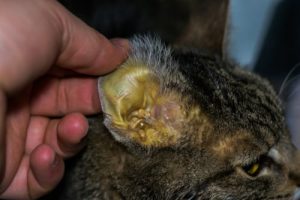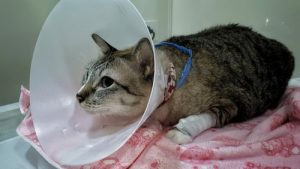Leptospirosis is a highly contagious bacterial disease that mostly affects dogs. It can also infect and cause severe disease in humans.
Leptospirosis in cats in the UK is extremely rare. Most cases of leptospirosis in cats do not show any clinical signs. Leptospirosis is spread through the urine of infected animals and through infected water sources. Cats usually catch the infection from eating rodents. Outdoor cats are more at risk.
Overview
What is leptospirosis in cats?
Leptospirosis is a contagious bacterial infection.
- It is spread in the urine and blood of infected animals, both domestic and wild such as rats, mice, pigs, cows, and dogs.
- Cats catch it through direct contact with infected animals.
- They can also catch it through infected water or soil (in puddles, lakes, rivers, etc.) Leptospirosis bacteria can survive in water for months
- The bacteria enters the body via the mouth, nose, or open wounds.
- In cats, symptoms are rare.
- Cats can be carriers of the disease, which means they can shed the infection in their urine without developing any symptoms.
- It has been reported that it can cause severe disease in cats and, sadly, death.
- There are several different types of leptospirosis that can cause different symptoms.
Symptoms
Symptoms of leptospirosis in cats
Cats often do not show any signs when infected with leptospirosis. The following symptoms have occasionally been found:
- Fever
- Lethargy or weakness
- Weight loss
- Not eating
- Drinking and peeing more than normal
- Vomiting and diarrhoea
- Jaundice (yellow colour of gums and eyes)
- Lameness

- Jaundice appears as yellow on the inside of the ears, eyes and gums
Risk
Are some cats more at risk of leptospirosis than others?
The risk factors for leptospirosis include the following:
- Outdoor cats who hunt
- Cats with FIV
Diagnosis
How is leptospirosis diagnosed in cats?
A full physical exam is the first step in the investigation. Treatment may already be started before the results of tests have returned if the disease is suspected. Tests include:
- General or specific blood tests to check organ function, especially kidney and liver
- Blood or urine tests to check for the Leptospirosis bacteria
- General urine tests
- Imaging: x-rays, ultrasound, or CT scans to check for damage to certain organs
Vet treatment
What’s the treatment for leptospirosis in cats?
Leptospirosis is very rare in cats. Treatment depends on how severe the disease is when it’s diagnosed. Cats may require hospitalisation for close monitoring of their vital signs, such as heart rate and blood pressure.
- Antibiotics, specific for leptospirosis, often given by injection into the vein
- Fluids into the vein to help with dehydration and electrolyte imbalances
- A urinary catheter may be needed
- Regular blood tests to check the liver and kidney function
- Anti-sickness medications
- Appetite stimulants
- Pain relief
- Nutritional support
Further treatment may be needed, depending on what organs are damaged and how severe the damage is. Leptospirosis can lead to anaemia, kidney disease, and liver disease. Long-term treatment may be needed for some cats, such as those with chronic kidney disease.

- Hospitalisation is often needed
An important factor in the treatment of leptospirosis is the isolation of infected cats. This is to prevent its spread to other animals and humans. Cats still shed the bacteria even after recovery, usually for 4-6 weeks, but it has also been shown that some cats can shed it for years.
The costs of treating leptospirosis can be very high due to the need for hospitalisation and isolation.
Sadly, cats may become extremely ill with leptospirosis, and euthanasia may be advised on the grounds of preventing suffering.
Home treatment
How to look after a cat with leptospirosis at home
Cats with leptospirosis may need hospitalisation in a vet practice, which can last for days to weeks. Once home, your cat will need close monitoring and isolation to prevent spread to people and other animals.
- Make sure your cat is eating and drinking normal amounts
- Allow them to rest and recover somewhere quiet and comfortable
- Check their body weight regularly to make sure they are not losing weight
- Give any medication as instructed by your vet. Be careful not to miss any doses.
- If the symptoms worsen, make sure to get your cat checked over right away
Isolation is needed for cats that are suspected or diagnosed with leptospirosis. Your vet will be able to advise for how long, but it is often for 4-6 weeks at least.
- Make sure to avoid contact with your cat’s urine. Always wear gloves and use a disinfectant to clean the urine.
- Wash your hands after any contact with your cat. Strict hygiene measures help prevent the spread.
Prevention
Tips on how to prevent leptospirosis in cats
- Unfortunately, there is no vaccine for leptospirosis in cats.
- Leptospirosis is more common in Europe. Make sure to take extra precautions when travelling with your cat.
- Take steps to prevent rodents in your house and garden: secure your rubbish, clean up any spillages immediately, and do not leave any pet food lying around.
- When possible, don’t let your cat eat rodents.
- Minimise contact with wild and farm animals.
- Keep your cat away from stagnant water.
- Cats that live with other pets who have been diagnosed with leptospirosis may need to be treated with a course of antibiotics.
Is my family at risk of catching leptospirosis?
Yes, leptospirosis can spread from animals to humans. It can cause serious disease in people. Speak to your GP if you have any concerns.
When to worry
When you should be worried about leptospirosis in cats
Leptospirosis is extremely rare in cats. There have only been a handful of cases reported in the UK.
Seek help from a vet if:
- You suspect your cat has leptospirosis
- Your cat has yellow gums or eyes
- Your cat has severe vomiting or diarrhoea
Call us and speak to one of our Joii vets if:
- You have any questions about vaccinations
- Your cat has mild vomiting or diarrhoea
- You have any questions about preventing leptospirosis








